List of unofficial presidents of the Philippines
The list of unofficial Presidents of the Philippines include people that Philippine historians and other figures have identified as having held the presidency of a government that intended to represent the Philippines but are not counted by the modern Government of the Philippines as an official President of the Philippines.
History
Andrés Bonifacio is considered by some historians to be the first President of the Philippines. He was the third Supreme President (Spanish: Presidente Supremo; Tagalog: Kataastaasang Pangulo) of the Katipunan secret society. Its Supreme Council, led by the Supreme President, coordinated provincial and district councils. When the Katipunan went into open revolt in August 1896 (the Cry of Balintawak), Bonifacio transformed it into a revolutionary government with him as President. While the term Katipunan remained, Bonifacio's government was also known as the Tagalog Republic (Spanish: Republica Tagala). (Although the word Tagalog refers to a specific ethnicity, Bonifacio used it to denote all indigenous people in the Philippines in place of Filipino which had colonial origins.)[1][2][3][4][5]
Some historians contend that including Bonifacio as a past president would imply that Macario Sakay and Miguel Malvar y Carpio should also be included.[6] Miguel Malvar y Carpio continued Emilio Aguinaldo's leadership of the First Philippine Republic after the latter's capture until his own capture in 1902. Macario Sakay founded a Tagalog Republic in 1902 as a continuation of Bonifacio's Katipunan. They are both considered by some scholars as "unofficial presidents". Along with Bonifacio, Malvar and Sakay are not recognized as Presidents by the Philippine government.[7][8]
Emilio Aguinaldo is officially recognized as the first President of the Philippines, but this is based on his term of office during the Malolos Republic, later known as the First Philippine Republic. Prior to this Aguinaldo had held the presidency of several revolutionary governments which are not counted in the succession of Philippine republics.
Manuel L. Quezon delegated his presidential duties to José Abad Santos, the then Chief Justice, when he former fled the Philippines amidst Japanese occupation of the islands to establish a government-in-exile. He is believed to have in effect became the Acting President of the Philippine Commonwealth though no legal document has been retrieved detailing the official transfer of the title of President to Abad Santos.[9]
List
| # | President (Birth–Death) | Took office | Left office | Party | Vice President | Government | ||
|---|---|---|---|---|---|---|---|---|
| A | 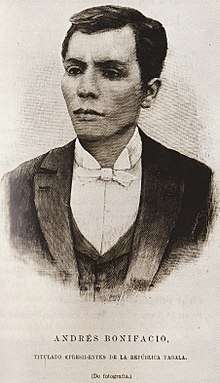 | Andres Bonifacio y de Castro (30 November 1863–10 May 1897) (Lived: 33 years) [5][10][11][12] | August 24, 1896[L 1] | March 22, 1897[L 2] or May 10, 1897[L 3] | Katipunan | Gregoria Álvarez de Jesús | Sovereign Tagalog Nation | |
| B | .jpg) | Emilio Aguinaldo y Famy (22 March 1869–6 February 1964) (Lived: 94 years) | March 22, 1897[L 4] | November 1, 1897[L 5] | Katipunan - later abolished (Magdalo faction) | Mariano Trias y Closas | Tejeros revolutionary government | |
| November 2, 1897[L 6] | December 14, 1897[L 7] | Independent | Republic of Biak-na-Bato | |||||
| May 24, 1898 | June 23, 1898 [L 8] | Dictatorial Republic[L 9] | ||||||
| June 23, 1898[L 10]</ref> | January 23, 1899[L 11] | Pre-Malolos revolutionary government | ||||||
| C | 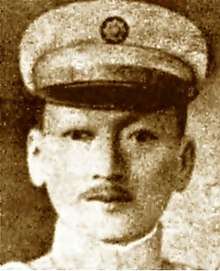 |
Francisco Macabulos y Soliman (17 September, 1871–30 August 1922) (Lived 50 years) | April 17, 1898 | May 19, 1898[L 12] | Independent (Formerly Katipunan) | Central Executive Committee | ||
| D | 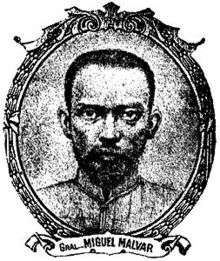 | Miguel Malvar y Carpio (27 September 1865–13 October 1911) (Lived: 46 years) [13] | April 1, 1901[L 13] | April 16, 1902[L 14] | Independent (Formerly Katipunan) | none (The 1899 Constitution did not provide for a Vice President.) | First Republic (Malolos Republic) | |
| E | 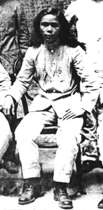 |
Macario Sakay y de León (1870–13 September 1907) (Lived 37 years) [14][15][16] | May 6, 1902[L 15] | July 14, 1906[L 16] | Independent (Formerly Katipunan) | Francisco Carreón y Marcos | Tagalog Republic | |
| F | .jpg) |
José Abad Santos (19 February 1886–2 May 1942) (Lived 56 years)[9] |
March 17, 1942 | May 2, 1942 | Independent | Philippine Commonwealth | ||
| G | 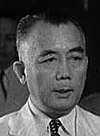 |
Jorge Bartolome Vargas ( 24 April 1890 –22 February 1980) (Lived 89 years) | January 23, 1942 | October 14, 1943[L 17] | KALIBAPI | none | Philippine Executive Commission | |
- Notes
- Term began when Bonifacio declared the establishment of the Tagalog Republic.
- Term ended after the Tejeros Convention.
- Executed for treason by Aguinaldo's government; Bonifacio did not recognize its validity and still acted as president.
- Term was established at the Tejeros Convention; Aguinaldo took his oath of office the day after (March 23), but did not fully assume the office until late April 1897.
- Term ended with the establishment of the Republic of Biak-na-Bato.
- Term began after the establishment of the Republic of Biak-na-Bato.
- Term ended when Aguinaldo signed the Pact of Biak-na-Bato.
- Term ended when Aguinaldo shifted from dictatorial to revolutionary governemt.
- Aguinaldo formally held the title of "Dictator", was not formally President until the end of the Dictatorial government.
- Term began with the declaration of a revolutionary government replacing the dictatorship.<ref name='pangulo.ph/prexy_efa'>"Emilio Aguinaldo y Famy". pangulo.ph. Archived from the original on 2004-12-05.
- Term ended with the inauguration of the Malolos Republic, considered the First Philippine Republic.
- Term ended upon the return of Aguinaldo to established a dictatorial republic.
- Term began when Malvar assumed the presidency after the capture of Aguinaldo.
- Term ended when Malvar surrendered in Batangas.
- Term began when Sakay declared the establishment of the Tagalog Republic (in the tradition of Bonifacio instead of Aguinaldo).
- Term ended when Sakay surrendered as part of an amnesty; he was executed a year later.
- Term ended upon the establishment of Second Philippine Republic.
Timeline

See also
- List of Presidents of the Philippines
- Timeline of Philippine sovereignty
- President of the Philippines
- Republic of Biak-na-Bato
- First Lady or First Gentleman of the Philippines
References
- Borromeo-Buehler & Borromeo 1998, pp. 25 (Item 3 in the list, referring to Note 41 at p.61, citing Guerrero, Encarnacion & Villegas);
^ Borromeo-Buehler & Borromeo 1998, pp. 26, "Formation of a revolutionary government";
^ Borromeo-Buehler & Borromeo 1998, pp. 135 (in "Document G", Account of Mr. Bricco Brigado Pantos). - Halili & Halili 2004, pp. 138–139.
- Severino, Howie (November 27, 2007), Bonifacio for (first) president, GMA News.
-
- Guerrero, Milagros; Schumacher, S.J., John (1998), Reform and Revolution, Kasaysayan: The History of the Filipino People, 5, Asia Publishing Company Limited, ISBN 962-258-228-1.
-
- Guerrero, Milagros; Encarnación, Emmanuel; Villegas, Ramón (1996), "Andrés Bonifacio and the 1896 Revolution", Sulyap Kultura, National Commission for Culture and the Arts, 1 (2): 3–12, archived from the original on 2010-11-15.
- Ambeth Ocampo (May 11, 2010). "Bonifacio, First President of the Philippines?". Philippine Daily Inquirer.
- manilatimes.net, Lawmaker: History wrong on Gen. Malvar Archived 2008-01-04 at the Wayback Machine
- Flores, Paul (August 12, 1995), Macario Sakay: Tulisán or Patriot?, Philippine History Group of Los Ángeles, archived from the original on June 9, 2007, retrieved 2007-04-08
- Orejas, Tonette. "Abad Santos, acting Commonwealth president, gets proper honors in place where he died". newsinfo.inquirer.net.
- Guererro, Francis Rodney; Songalia (1998). Reform and Revolution. Kasaysayan: The History of the Filipino People. 5. Asia Publishing Company Limited. ISBN 962-258-228-1.
- Borromeo-Buehler, Soledad; Borromeo, Soledad Masangkay (1998). The Cry of Balintawak: a contrived controversy. Quezon City: Ateneo de Manila University Press. ISBN 971-550-278-4.CS1 maint: ref=harv (link)
- Severino, Howie (2007-11-27). "Bonifacio for (first) president". gmanews.tv. GMA Network. Retrieved 2009-08-20.
- Cruz, Maricel V. (2008-02-02). "Lawmaker: History wrong on Gen. Malvar". www.manilatimes.net. Manila Times. Archived from the original on 2008-12-11. Retrieved 2009-08-20.
- Agoncillo, Teodoro (1990) [1960]. History of the Filipino People (8th ed.). Quezon City: Garotech Publishing Inc. ISBN 971-10-2415-2.
- Flores, Paul (1995-08-12). "Macario Sakay: Tulisán or Patriot?". Philippine History Group of Los Angeles. Archived from the original on 2007-06-09. Retrieved 2007-04-08.
- Tan, Michael (2007-09-21). "September's heroes". www.inquirer.net. Philippine Daily Inquirer. Retrieved 2009-08-20.